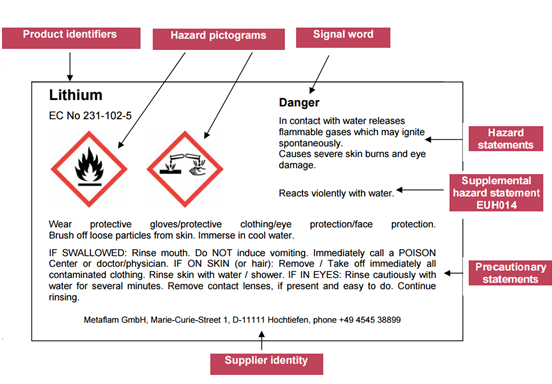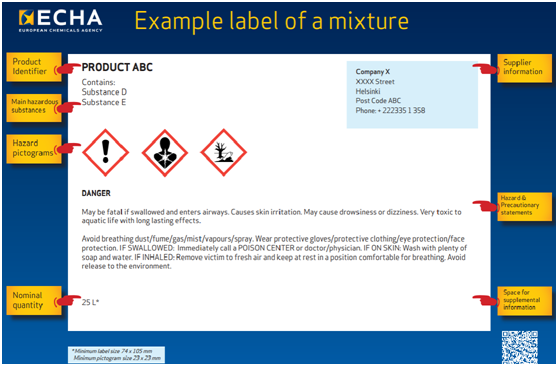
CLP Regulation
CLP is a Regulation (EC) No 1272/2008 of the European Parliament and of the Council of 16 December 2008 on Classification, Labelling and Packaging of substances and mixtures. The CLP Regulation
ensures that the hazards presented by chemicals are clearly communicated to workers and consumers in the European Union through classification and labelling of chemicals to protect human health and
the environment.
Our Classification and Labelling Services
- Chemicals classification according to CLP/GHS regulation
- Chemicals Labelling accroding to CLP/GHS regulation
- Classification and Labelling of mixture according to CLP/GHS regulation
- Checkness of C&L as CLP/GHS
- Checkness of SDS/eSDS
- Classification and Labelling Notification
- Protection of the client confidential business information
Official Definitions
Hazard class: means the nature of the physical, health or environmental hazard;
Hazard category: means the division of criteria within each hazard class, specifying hazard severity;
Hazard pictogram: means a graphical composition that includes a symbol plus other graphic elements, such as a border, background pattern or colour that is intended to convey specific information on the hazard concerned;
Signal word: means a word that indicates the relative level of severity of hazards to alert the reader to a potential hazard; the following two levels are distinguished:
(a) ‘Danger’ means a signal word indicating the more severe hazard categories;
(b) ‘Warning’ means a signal word indicating the less severe hazard categories;
Hazard statement: means a phrase assigned to a hazard class and category that describes the nature of the hazards of a hazardous substance or mixture, including, where appropriate, the degree of hazard;
Precautionary statement: means a phrase that describes recommended measure(s) to minimise or prevent adverse effects resulting from exposure to a hazardous substance or mixture due to its use or disposal;
UN RTDG: means the United Nations Recommendations on the Transport of Dangerous Goods;
Notifier: means the manufacturer or the importer, or group of manufacturers or importers notifying to the Agency;
Cut-off value: means a threshold of any classified impurity, additive or individual constituent in a substance or in a mixture, above which threshold these shall be taken into account for determining if the substance or the mixture, respectively, shall be classified;
Concentration limit: means a threshold of any classified impurity, additive or individual constituent in a substance or in a mixture that may trigger classification of the substance or the mixture, respectively;Differentiation: means distinction within hazard classes depending on the route of exposure or the nature of the effects;
M-factor: means a multiplying factor. It is applied to the concentration of a substance classified as hazardous to the aquatic environment acute category 1 or chronic category 1, and is used to derive by the summation method the classification of a mixture in which the substance is present;
Package: means the complete product of the packing operation, consisting of the packaging and its contents;
Packaging: means one or more receptacles and any other components or materials necessary for the receptacles to perform their containment and other safety functions;
Intermediate packaging: means packaging placed between inner packaging, or articles, and outer packaging.
Classification
self-classification: In most of the cases, suppliers need to decide on the classification of a substance or mixture. This is called self-classification. There are normally four basic steps to self-classify a substance or a mixture:
- collection of available information;
- evaluation of the adequacy and reliability of the information;
- review of the information against the classification criteria;
- decision on classification.
Harmonised classification and labeling: In some cases, the decision on the classification of a chemical is taken at Community level. It is mandatory for the suppliers of the respective substance or mixture to apply this harmonised classification and labelling. This process often concerns the most hazardous substances. These are usually carcinogenic, mutagenic, toxic for reproduction or respiratory sensitisers. The harmonisation of the classifications aims at protecting human health and the environment while enhancing competitiveness and innovation.
Labelling
Suppliers must label a substance or mixture contained in packaging according to CLP before placing it on the market either when:
A substance is classified as hazardous;
A mixture contains one or more substances classified as hazardous above a certain threshold.
CLP defines the content of the label and the organisation of the various labelling elements.
The label includes:
- The name, address and telephone number of the supplier;
- The nominal quantity of a substance or mixture in the packages made available to the general public (unless this quantity is specified elsewhere on the package);
- Product identifiers;
- Where applicable, hazard pictograms, signal words, hazard statements, precautionary statements and supplemental information required by other legislation.
A hazard pictogram is an image on a label that includes a warning symbol and specific colours intended to provide information about the damage a particular substance or mixture can cause to our health or the environment. The pictograms are in the shape of a red diamond with a white background.
C&L Inventory
The Classification and Labelling
(C&L) Inventory is a database that contains basic classification and labelling information on notified and registered substances received from manufacturers and importers. It also
includes the list of harmonised classifications (Tables 3.1 and 3.2 of Annex VI to the CLP Regulation) and the names of harmonised substances.
Each notification should include:
- Name and contact details of the notifier;
- Identity of the substance, including the name and other identifiers, information related to molecular and structural formula, composition, nature and amount of additives;
- Classification of the substance according to the CLP criteria;
- Reason for "no classification" if the substance is classified in some but not all hazard classes or differentiations indicating whether this is due to a lack of data, inconclusive data, or data which is conclusive for non-classification;
- Specific concentration limits or M-factors, where relevant, including a justification for setting them;
- Label elements, including hazard pictograms, signal words, hazard statements and any supplemental hazard statements.
Useful Links
CLP Regulation
http://eur-lex.europa.eu/legal-content/EN/TXT/?uri=CELEX:02008R1272-20170101
C&L Inventory
https://echa.europa.eu/information-on-chemicals/cl-inventory-database
CLP Pictograms
https://echa.europa.eu/chemicals-in-our-life/clp-pictograms
Guidance on Labelling and Packaging
https://echa.europa.eu/documents/10162/13562/clp_labelling_en.pdf/89628d94-573a-4024-86cc-0b4052a74d65



